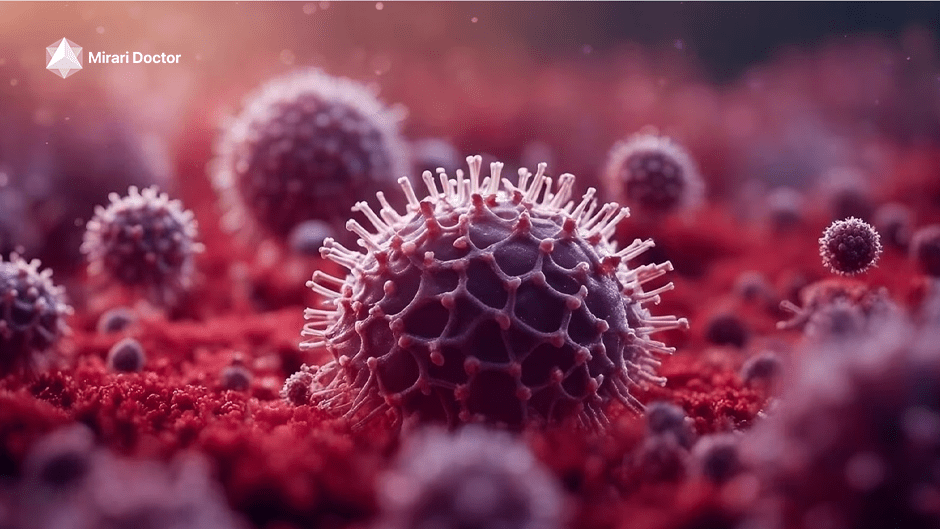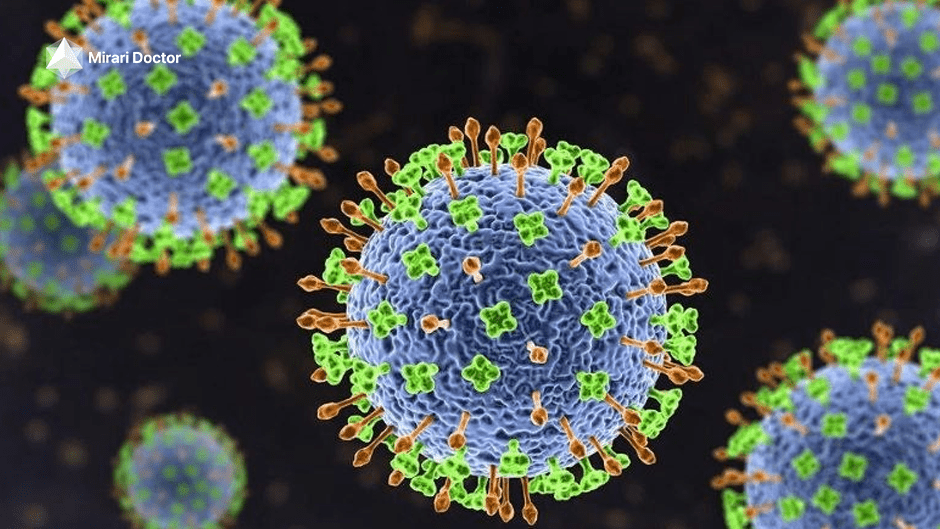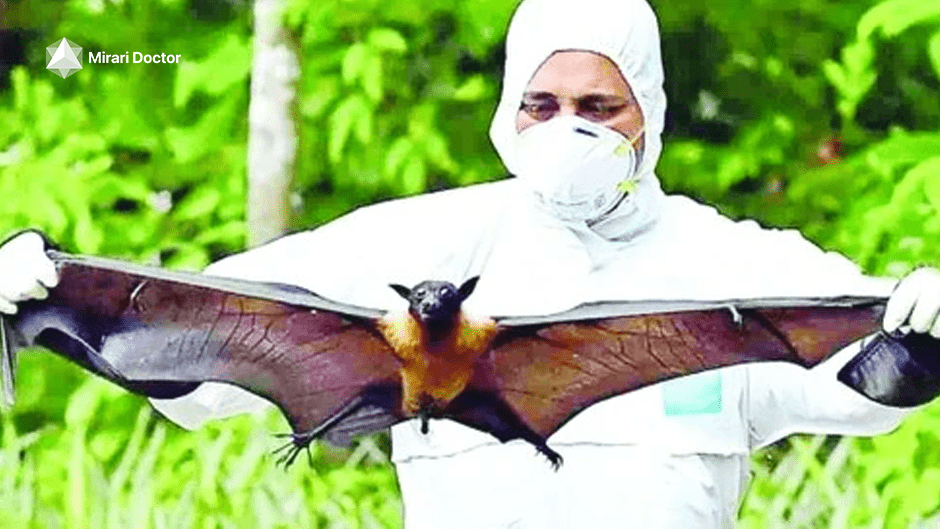Introduction
Nipah virus (NiV) is a zoonotic virus that can cause severe respiratory illness and encephalitis in humans. It was first identified in Malaysia in 1998 and has since been reported in several countries in South and Southeast Asia.[1]The virus is primarily transmitted to humans through direct contact with infected animals, such as pigs or fruit bats, or through consumption of contaminated food products.[2]The aim of this guide is to provide healthcare professionals with a comprehensive overview of the symptoms, causes, diagnostic steps, possible interventions, and patient education for Nipah virus.
Codes
- ICPC-2 Code: NA3 Nipah virus (NiV)
- ICD-10 Code: A98.8 Other specified viral haemorrhagic fevers
Symptoms
- Fever: High fever is one of the initial symptoms of Nipah virus infection. The fever may be accompanied by chills and body aches.[3]
- Headache: Severe headache is a common symptom of Nipah virus infection. The headache may be persistent and worsen over time.
- Respiratory symptoms: Patients with Nipah virus infection may experience respiratory symptoms such as cough, sore throat, and difficulty breathing.[4]
- Encephalitis: Nipah virus can cause inflammation of the brain, leading to symptoms such as confusion, disorientation, and seizures.[5]
- Nausea and vomiting: Some patients with Nipah virus infection may experience nausea and vomiting.
- Muscle pain: Muscle pain, also known as myalgia, is a common symptom of Nipah virus infection.
- Fatigue: Patients with Nipah virus infection may experience extreme fatigue and weakness.
Causes
- Direct contact with infected animals: Nipah virus can be transmitted to humans through direct contact with infected animals, such as pigs or fruit bats.[6]
- Consumption of contaminated food products: Nipah virus can also be transmitted to humans through consumption of contaminated food products, such as raw date palm sap[7].
Diagnostic Steps
Medical History
- Gather information about the patient’s recent travel history, including any visits to areas where Nipah virus outbreaks have occurred.
- Ask about any exposure to animals, especially pigs or fruit bats.
- Inquire about any symptoms the patient may be experiencing, such as fever, headache, respiratory symptoms, or neurological symptoms.[8]
Physical Examination
- Perform a thorough physical examination, paying special attention to any signs or findings indicative of respiratory or neurological involvement.
- Look for signs of fever, respiratory distress, altered mental status, and neurological deficits.[9]
Laboratory Tests
- Nucleic acid amplification tests (NAAT): NAAT can be used to detect the presence of Nipah virus RNA in respiratory secretions or cerebrospinal fluid.
- Serology: Serological tests can be used to detect the presence of Nipah virus-specific antibodies in the patient’s blood.
- Polymerase chain reaction (PCR): PCR can be used to amplify and detect Nipah virus RNA in clinical samples.
- ELISA: Enzyme-linked immunosorbent assay (ELISA) can be used to detect Nipah virus-specific antibodies in the patient’s blood.[10]
Diagnostic Imaging
- Chest X-ray: A chest X-ray may be performed to assess the patient’s respiratory status and look for any signs of pneumonia or other respiratory complications.
- CT scan or MRI: A CT scan or MRI of the brain may be performed to assess the extent of neurological involvement and look for any signs of encephalitis.
Other Tests
- Lumbar puncture: A lumbar puncture may be performed to collect cerebrospinal fluid for analysis, including testing for the presence of Nipah virus RNA.
- Electroencephalogram (EEG): An EEG may be performed to assess brain function and look for any abnormalities indicative of encephalitis.
Follow-up and Patient Education
- Patients diagnosed with Nipah virus should be closely monitored for any worsening of symptoms or development of complications.
- Provide patients with information about the importance of infection control measures, such as hand hygiene and avoiding contact with infected animals.
- Educate patients about the potential long-term effects of Nipah virus infection, such as neurological sequelae, and the need for ongoing follow-up care.

Possible Interventions
Traditional Interventions
Medications:
Top 5 drugs for Nipah virus (NiV):
- Ribavirin:
- Cost: $100-$500 per course of treatment.
- Contraindications: Hypersensitivity to ribavirin, severe anemia, or renal impairment.
- Side effects: Nausea, vomiting, anemia.
- Severe side effects: Hemolytic anemia, liver toxicity.
- Drug interactions: None reported.
- Warning: Close monitoring of renal function and hemoglobin levels is required.
- Intensive supportive care:
- Cost: Varies depending on the level of care required.
- Contraindications: None.
- Side effects: None.
- Severe side effects: None.
- Drug interactions: None.
- Warning: None.
- Antipyretics (e.g., Acetaminophen):
- Cost: $5-$10 per course of treatment.
- Contraindications: Hypersensitivity to acetaminophen, severe liver disease.
- Side effects: None when used as directed.
- Severe side effects: None.
- Drug interactions: None reported.
- Warning: Do not exceed the recommended dosage.
- Anticonvulsants (e.g., Phenobarbital, Valproic acid):
- Cost: $10-$50 for a 30-day supply.
- Contraindications: Hypersensitivity to the medication and liver disease.
- Side effects: Drowsiness, dizziness, and nausea.
- Severe side effects: Liver toxicity, pancreatitis, and Stevens-Johnson syndrome.
- Drug interactions: Many potential drug interactions, including with other antiepileptic
- Warning: Close monitoring of liver function and blood levels of the medication is required.
- Antiviral therapy (e.g., Oseltamivir):
- Cost: $50-$100 for a 5-day course.
- Contraindications: Hypersensitivity to oseltamivir and severe renal impairment.
- Side effects: Nausea, vomiting, and headache.
- Severe side effects: None reported.
- Drug interactions: None reported.
- Warning: Start treatment as soon as possible after symptom onset.
Alternative Drugs:
- Convalescent plasma therapy: Administration of plasma from recovered Nipah virus patients.
- Cost: Varies depending on availability and location.
- Experimental antiviral drugs: Various experimental antiviral drugs are being investigated for their potential effectiveness against Nipah virus. Cost: Varies depending on availability and participation in clinical trials.
Surgical Procedures:
- There are no surgical procedures specifically indicated for the treatment of NiV infection.
Alternative Interventions
- Supportive care: Providing supportive care, such as intravenous fluids, oxygen therapy, and management of complications, can help improve patient outcomes. Cost: Varies depending on the level of care required.
- Experimental therapies: Various experimental therapies, such as monoclonal antibodies and antiviral peptides, are being investigated for their potential effectiveness against Nipah virus. Cost: Varies depending on availability and participation in clinical trials.
- Traditional medicine: Some traditional medicines, such as herbal remedies and traditional Chinese medicine, have been used in the treatment of viral infections. Cost: Varies depending on the specific treatment and availability.
Lifestyle Interventions
- Infection control measures: Educate patients about the importance of hand hygiene, avoiding contact with infected animals, and practicing safe food handling and preparation. Cost: Minimal.
- Rest and hydration: Encourage patients to get plenty of rest and stay hydrated to support their immune system. Cost: Minimal.
- Nutritional support: Provide patients with a balanced diet to support their immune system and overall health. Cost: Varies depending on the specific dietary requirements.
- Psychological support: Offer psychological support to patients and their families to help them cope with the emotional and psychological impact of the disease. Cost: Varies depending on the availability of mental health services.
It is important to note that the cost ranges provided are approximate and may vary depending on the location and availability of the interventions.

Mirari Cold Plasma Alternative Intervention
Understanding Mirari Cold Plasma
- Safe and Non-Invasive Treatment: Mirari Cold Plasma is a safe and non-invasive treatment option for various skin conditions. It does not require incisions, minimizing the risk of scarring, bleeding, or tissue damage.
- Efficient Extraction of Foreign Bodies: Mirari Cold Plasma facilitates the removal of foreign bodies from the skin by degrading and dissociating organic matter, allowing easier access and extraction.
- Pain Reduction and Comfort: Mirari Cold Plasma has a local analgesic effect, providing pain relief during the treatment, making it more comfortable for the patient.
- Reduced Risk of Infection: Mirari Cold Plasma has antimicrobial properties, effectively killing bacteria and reducing the risk of infection.
- Accelerated Healing and Minimal Scarring: Mirari Cold Plasma stimulates wound healing and tissue regeneration, reducing healing time and minimizing the formation of scars.
Mirari Cold Plasma Prescription
| Mild | Moderate | Severe |
| Mode setting: 1 (Infection) Location: Localized Morning: 15 minutes, Evening: 15 minutes | Mode setting: 1 (Infection) Location: Localized Morning: 30 minutes, Lunch: 30 minutes, Evening: 30 minutes | Mode setting: 1 (Infection) Location: Localized Morning: 30 minutes, Lunch: 30 minutes, Evening: 30 minutes |
| Mode setting: 2 (Wound) Location: 7 (Neuro system & ENT) Morning: 15 minutes, Evening: 15 minutes | Mode setting: 2 (Wound) Location: 7 (Neuro system & ENT) Morning: 30 minutes, Lunch: 30 minutes, Evening: 30 minutes | Mode setting: 2 (Wound) Location: 7 (Neuro system & ENT) Morning: 30 minutes, Lunch: 30 minutes, Evening: 30 minutes |
| Mode setting: 3 (Antiviral) Location: 6 (Throat, Lymphatic & Thyroid) Morning: 15 minutes, Evening: 15 minutes | Mode setting: 3 (Antiviral) Location: 6 (Throat, Lymphatic & Thyroid) Morning: 30 minutes, Lunch: 30 minutes, Evening: 30 minutes | Mode setting: 3 (Antiviral) Location: 6 (Throat, Lymphatic & Thyroid) Morning: 30 minutes, Lunch: 30 minutes, Evening: 30 minutes |
| Mode setting: 7 (Immuno) Location: 1 (Sacrum) Morning: 15 minutes, Evening: 15 minutes | Mode setting: 7 (Immuno) Location: 1 (Sacrum) Morning: 30 minutes, Lunch: 30 minutes, Evening: 30 minutes | Mode setting: 7 (Immuno) Location: 1 (Sacrum) Morning: 30 minutes, Lunch: 30 minutes, Evening: 30 minutes |
| Total Morning: 60 minutes approx. $10 USD, Evening: 60 minutes approx. $10 USD | Total Morning: 120 minutes approx. $20 USD, Lunch: 120 minutes approx. $20 USD, Evening: 120 minutes approx. $20 USD, | Total Morning: 120 minutes approx. $20 USD, Lunch: 120 minutes approx. $20 USD, Evening: 120 minutes approx. $20 USD, |
| Usual treatment for 7-60 days approx. $140 USD – $1200 USD | Usual treatment for 6-8 weeks approx. $2,520USD – $3,360 USD | Usual treatment for 3-6 months approx. $5,400 USD – $10,800 USD |
 |
|
Use the Mirari Cold Plasma device to treat Nipah virus (NiV) effectively.
WARNING: MIRARI COLD PLASMA IS DESIGNED FOR THE HUMAN BODY WITHOUT ANY ARTIFICIAL OR THIRD PARTY PRODUCTS. USE OF OTHER PRODUCTS IN COMBINATION WITH MIRARI COLD PLASMA MAY CAUSE UNPREDICTABLE EFFECTS, HARM OR INJURY. PLEASE CONSULT A MEDICAL PROFESSIONAL BEFORE COMBINING ANY OTHER PRODUCTS WITH USE OF MIRARI.
Step 1: Cleanse the Skin
- Start by cleaning the affected area of the skin with a gentle cleanser or mild soap and water. Gently pat the area dry with a clean towel.
Step 2: Prepare the Mirari Cold Plasma device
- Ensure that the Mirari Cold Plasma device is fully charged or has fresh batteries as per the manufacturer’s instructions. Make sure the device is clean and in good working condition.
- Switch on the Mirari device using the power button or by following the specific instructions provided with the device.
- Some Mirari devices may have adjustable settings for intensity or treatment duration. Follow the manufacturer’s instructions to select the appropriate settings based on your needs and the recommended guidelines.
Step 3: Apply the Device
- Place the Mirari device in direct contact with the affected area of the skin. Gently glide or hold the device over the skin surface, ensuring even coverage of the area experiencing.
- Slowly move the Mirari device in a circular motion or follow a specific pattern as indicated in the user manual. This helps ensure thorough treatment coverage.
Step 4: Monitor and Assess:
- Keep track of your progress and evaluate the effectiveness of the Mirari device in managing your Nipah virus (NiV). If you have any concerns or notice any adverse reactions, consult with your health care professional.
Note
This guide is for informational purposes only and should not replace the advice of a medical professional. Always consult with your healthcare provider or a qualified medical professional for personal advice, diagnosis, or treatment. Do not solely rely on the information presented here for decisions about your health. Use of this information is at your own risk. The authors of this guide, nor any associated entities or platforms, are not responsible for any potential adverse effects or outcomes based on the content.
Mirari Cold Plasma System Disclaimer
- Purpose: The Mirari Cold Plasma System is a Class 2 medical device designed for use by trained healthcare professionals. It is registered for use in Thailand and Vietnam. It is not intended for use outside of these locations.
- Informational Use: The content and information provided with the device are for educational and informational purposes only. They are not a substitute for professional medical advice or care.
- Variable Outcomes: While the device is approved for specific uses, individual outcomes can differ. We do not assert or guarantee specific medical outcomes.
- Consultation: Prior to utilizing the device or making decisions based on its content, it is essential to consult with a Certified Mirari Tele-Therapist and your medical healthcare provider regarding specific protocols.
- Liability: By using this device, users are acknowledging and accepting all potential risks. Neither the manufacturer nor the distributor will be held accountable for any adverse reactions, injuries, or damages stemming from its use.
- Geographical Availability: This device has received approval for designated purposes by the Thai and Vietnam FDA. As of now, outside of Thailand and Vietnam, the Mirari Cold Plasma System is not available for purchase or use.
References
- Chua KB, et al. Nipah virus: a recently emergent deadly paramyxovirus. Science. 2000;288(5470):1432-1435.
- Luby SP, et al. Foodborne transmission of Nipah virus, Bangladesh. Emerg Infect Dis. 2006;12(12):1888-1894.
- World Health Organization. Nipah virus.//www.who.int/news-room/fact-sheets/detail/nipah-virus
- Centers for Disease Control and Prevention. Nipah Virus (NiV).//www.cdc.gov/vhf/nipah/index.html
- Goh KJ, et al. Clinical features of Nipah virus encephalitis among pig farmers in Malaysia. N Engl J Med. 2000;342(17):1229-1235.
- Clayton BA. Nipah virus: transmission of a zoonotic paramyxovirus. Curr Opin Virol. 2017;22:97-104.
- Rahman MA, et al. Date palm sap linked to Nipah virus outbreak in Bangladesh, 2008. Vector Borne Zoonotic Dis. 2012;12(1):65-72.
- Chong HT, et al. Nipah encephalitis outbreak in Malaysia, clinical features in patients from Seremban. Can J Neurol Sci. 2002;29(1):83-87.
- Wong KT, et al. Nipah virus infection: pathology and pathogenesis of an emerging paramyxoviral zoonosis. Am J Pathol. 2002;161(6):2153-2167.
- Daniels P, et al. Diagnosis and molecular characterization of Nipah virus infections. Curr Top Microbiol Immunol. 2007;315:43-60.
Related articles
Made in USA





